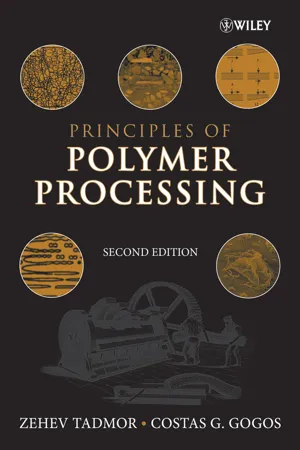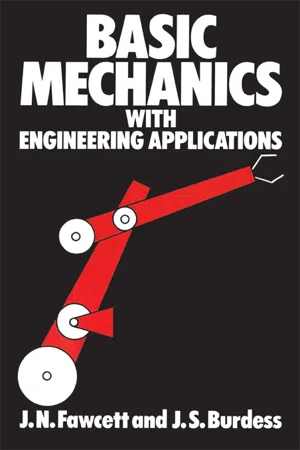Equilibrium Equations
Equilibrium equations are mathematical expressions used to analyze the balance of forces and moments acting on a system. They are fundamental in engineering and physics for determining the stability and behavior of structures and objects. These equations are derived from the principles of statics and are essential for solving problems related to structural design and mechanical systems.
6 Key excerpts on "Equilibrium Equations"
- eBook - ePub
Structure for Architects
A Primer
- Ramsey Dabby, Ashwani Bedi(Authors)
- 2012(Publication Date)
- Wiley(Publisher)
...CHAPTER 6 Stability and Equilibrium Authors' Note: Stability and equilibrium are closely related terms, frequently used interchangeably. The difference is semantically debatable and not particularly relevant to the larger concepts of structural engineering. At times the use of the terms may seem inconsistent or blurred, but for our purposes we'll generally use stability when referring to structures as a whole and equilibrium when referring to individual members within a structure. Although equilibrium can be dynamic or static, we'll use the term to refer to static equilibrium, the typical condition of concern for structures. 6.1 Introduction Stability is the condition in which gravity and lateral loads that tend to crush, slide, bend, or topple a structure are resisted so that the structure, as a whole, does not move. Equilibrium is the condition in which all forces acting on a body are in balance so that the body does not move. Structural engineering is primarily concerned with applying the principles of stability and equilibrium to calculate all forces acting on a structure and its individual members, then selecting the size, shape, and material to resist those forces with a reasonable margin of safety. Let's continue with our Chapter 5 examples of the crate and the seesaw in order to demonstrate the conditions for equilibrium. 6.2 Translational Equilibrium In Figure 6.1a, the crate in Chapter 5 continues to be pushed by the man until it comes up against a wall and can go no further. The applied force on the crate (the man's push) is resisted by a reactive force on the crate (the wall) acting in an equal and opposite direction. In addition, the downward force of gravity (the crate's weight) is resisted by the reactive upward force of the ground (through the crate's wheels) acting in an equal and opposite direction (Figure 6.1b)...
- eBook - ePub
- Paul McMullin, Jonathan Price, Paul W. McMullin, Jonathan S. Price(Authors)
- 2016(Publication Date)
- Routledge(Publisher)
...In contrast, a tightrope walker masters the laws of equilibrium using both mental and physical skills. Intuitive understanding of balance is something we learn as children though tightrope walkers have a keen awareness of it. For the structural engineer, equilibrium is the ultimate goal; strength is a part of that goal. Strength without equilibrium promotes a false sense of security. If you feel comfortable with the statics of force vectors, you can move on to rotational equilibrium and then to structural analysis. Endnotes 1 Aristotle—also attributed to Archytas, Mechanica. 2 Archimedes, On the Equilibrium on Planes. 3 Sir Isaac Newton, Philosophiæ Naturalis Principia Mathematica (London: Government publication, English translation by Andrew Motte, 1729). 4 Marcel Pavoz, Otis Elevator. Sheave array of a self-propelled elevator using a linear motor on the counterweight, Patent #EP 0402148 A1, filed June 7, 1990, Publication date May 11, 1994....
- eBook - ePub
- Zehev Tadmor, Costas G. Gogos(Authors)
- 2013(Publication Date)
- Wiley-Interscience(Publisher)
...We believe that it isimportant for every student or reader to work through these derivations at least once. We then discuss the nature of the stress and rate of deformation tensors, demonstrate the use of the balance equations for problem solving with Newtonian fluids using analytical and numerical techniques, discuss the lubrication approximation, which is very useful in modeling of polymer processing operations, and discuss the broad principles of mathematical modeling of complex processes. 2.2 THE BALANCE EQUATIONS Since in “transport processes” mass, momentum, and energy are transported from one part of the medium to another, it is essential that proper “bookkeeping” be applied to keep track of these quantities. This can be done using balance equations, which are the mathematical statements of the physical laws of conservation. These are very general laws that always hold, and they apply to all media: solids or fluids, stationary or flowing. These equations can be formulated over a specified macroscopic volume, such as an extruder, or a microscopic volume taking the form of a differential (field) equation that holds at every point of the medium. In the former case, the balance holds over the extensive quantities of mass, momentum, and energy, whereas in the latter case, it holds over their intensive counterparts of density, specific momentum, and specific energy, respectively. In the formulation of the microscopic balance equations, the molecular nature of matter is ignored and the medium is viewed as a continuum. Specifically, the assumption is made that the mathematical points over which the balance field-equations hold are big enough to be characterized by property values that have been averaged over a large number of molecules, so that from point to point there are no discontinuities. Furthermore, local equilibrium is assumed...
- Kenneth Derucher, Chandrasekhar Putcha, Uksun Kim, Hota V.S. GangaRao(Authors)
- 2022(Publication Date)
- CRC Press(Publisher)
...Part I Analysis of Statically Determinate Structures 1 Solving Reactions Using Equations of Force DOI: 10.1201/9781003246633-2 1.1 Equations of Equilibrium When solving for reactions in a beam, one of the most important concepts to remember is that the member (and the structure as a whole) is in equilibrium. This means that every force and moment acting on the structure is balanced by another, and the entire system remains at rest. This state of rest, or equilibrium, can be described with the following three equations of equilibrium. ∑ F x = 0 ∑ F y = 0 ∑ M O = 0 (1.1) where F x represents forces along the horizontal or x -axis, F y represents forces along the vertical or y -axis, and M O represents the sum of the moments around any point on the beam. Since these three equations can be assumed to be true for all problems, they are used in solving essentially all reactions in a structure. 1.2 Determinacy of a Beam One limiting factor with the equations of equilibrium is that they can only solve up to three unknowns in a problem that is identified in a single plane. When a problem can be solved using only these equations, it is referred to as statically determinate structure. If a structure has four or more unknowns, the problem becomes impossible to solve solely using equations of equilibrium and can be called statically indeterminate. The simplest way to determine if a structure is statically determinate or indeterminate is to draw the free body diagram of it, and then determine the number of reactions that need to be solved for. Several examples of this process are presented below. There are other factors that can affect whether a beam is statically determinate or indeterminate, such as hinges or shear releases...
- eBook - ePub
Design-Tech
Building Science for Architects
- Thomas Leslie, Robert Whitehead(Authors)
- 2014(Publication Date)
- Routledge(Publisher)
...20 Forces, Loads, and Equilibrium DOI: 10.4324/9781315817057-20 Structural design Historical overview and professional responsibilities Forces Definitions and representations Free body diagrams Vector geometry: representations and calculation methods Loads Classifications and representations Types—concentrated, distributed, gravity, and lateral Live vs. dead, and environmental Load transfer Tributary area Element analysis Equilibrium Definitions Rotational vs. translational equilibrium Equilibrium in support conditions Introduction Structural design involves the artful integration of load-resisting materials, forms, and components in the creation of a strong, stable, stiff, and serviceable buildings. Somewhat uniquely, structural design must synthesize a broad range of quantitative and qualitative aspects of design and construction. The process of selecting, developing, and integrating a structural system and its components into a design project has a profound influence on the building's form, behavior, budget, and overall design aesthetic. The sciences behind structural design principles are all relatively recent, as is the structural engineering profession itself. For centuries, structural design was considered part of the tasks assigned to the architect/master builder. Rules of thumb, intuitive solutions, and “collected wisdom” became the unofficial—and not always successful—approach taken by these designers. The Ecole Polytechnique in Paris in the mid-eighteenth century established structural design engineering as its own discipline. Over the last few centuries, the profession has benefited by integrating a myriad of new information into designs, including the reliable standards for the capabilities of materials, an ever evolving set of advanced modeling and analysis tools, and new construction and manufacturing techniques...
- eBook - ePub
- J Jones, J Burdess, J Fawcett(Authors)
- 2012(Publication Date)
- Routledge(Publisher)
...Equation (4.39) describes the rotational motion of the body and the static case is obtained by setting the accelerations Q, Q and to zero. For this special case the summation of the moments of the external forces about any point Q must be zero. Using eqn (3.11), the conditions for static equilibrium of a rigid body may be written as i.e. the vector sum of all the external forces acting on the body must be zero, and the sum of their moments about any arbitrary point Q must also be zero. In component form these equations may be expressed as where Σ F xi and Σ F yi are the sums of the components of the external forces in two perpendicular directions and Σ M Q is the sum of the moments of the external forces about any point Q. 3.4 Alternative formulations of equilibrium conditions The three equations (3.20), which describe the equilibrium of a rigid body in a plane, may be formulated in different ways. In certain applications, these alternatives can provide a more elegant solution to a problem. Let us consider the rigid body shown in Fig. 3.14(a) with a number of external forces F 1 … F i … F n applied to it. F IG. 3.14 If the body is in equilibrium then the sum of the moments of these forces about any point Q must be zero. It is convenient to consider the forces F i in components F xi, F yi along OX and OY as shown in Fig. 3.14(b)...





